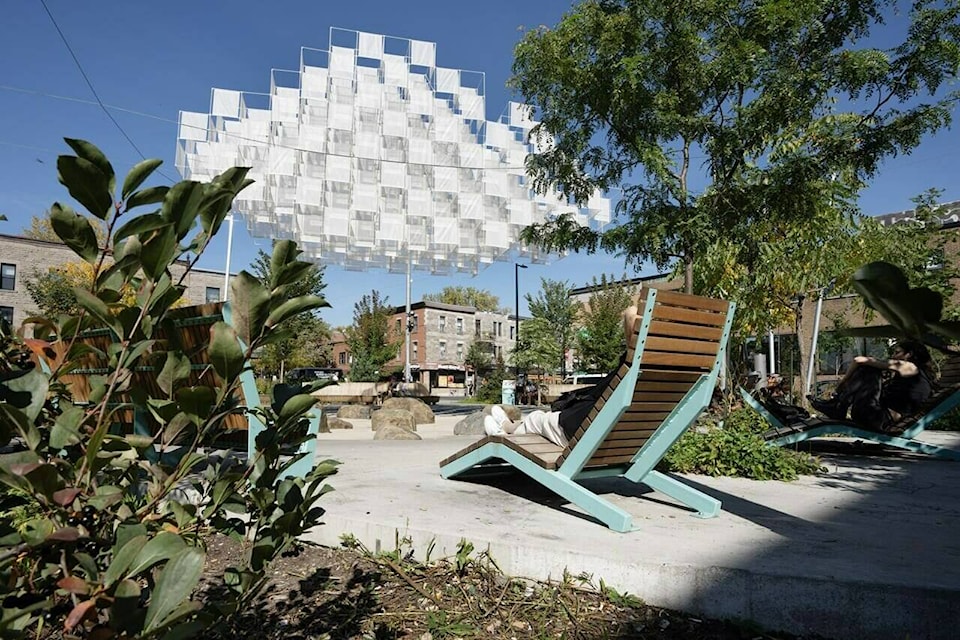From green roofs in Toronto to Vancouverļ¶–Ŗ≤›—–ĺŅňýôs rain city strategy, Canadian cities are looking to become ļ¶–Ŗ≤›—–ĺŅňýúspongesļ¶–Ŗ≤›—–ĺŅňýĚ in order to help mitigate some of the effects of extreme rainfall events.
In Montreal, Mayor Val√©rie Plante announced last week that the city plans to develop some 30 additional ļ¶–Ŗ≤›—–ĺŅňýúsponge parksļ¶–Ŗ≤›—–ĺŅňýĚ designed to catch and absorb rainwater and keep it from flowing into overburdened sewers during extreme rain events.
Those, combined with an additional 400 ļ¶–Ŗ≤›—–ĺŅňýúsponge sidewalks,ļ¶–Ŗ≤›—–ĺŅňýĚ featuring added vegetation squares, will help the city retain the equivalent of three Olympic swimming pools in water at ļ¶–Ŗ≤›—–ĺŅňýúhalf the cost of underground works,ļ¶–Ŗ≤›—–ĺŅňýĚ the city said in a news release.
Melanie Glorieux, a sustainable landscape planner with the firm Rousseau Lefebvre said that while the concept of building a ļ¶–Ŗ≤›—–ĺŅňýúsponge cityļ¶–Ŗ≤›—–ĺŅňýĚ isnļ¶–Ŗ≤›—–ĺŅňýôt new, itļ¶–Ŗ≤›—–ĺŅňýôs an idea that more and more municipalities are embracing as they cope with extreme weather.
The idea, she said, is to divert stormwater into low areas or channels planted with trees, shrubs and grasses, so that more of it is absorbed on the surface and less flows into sewers, lakes or rivers. As an added benefit, the plants filter the water before it enters the system, removing some of the pollutants it picks up from streets.
ļ¶–Ŗ≤›—–ĺŅňýúFirstly, we reduce the quantity of water (sent to sewers), and secondly, we improve the quality of what is there,ļ¶–Ŗ≤›—–ĺŅňýĚ she said
The goal is to reverse some of the harm done by the last 40 to 50 years of car-oriented urban development, which involved replacing natural spaces that soak up water with impermeable infrastructure such as roads and parking lots. In place of absorption, water was redirected to underground sewer systems, which can become overwhelmed by heavy rain, causing flooding and contamination of rivers.
The sponge city concept, which first rose to prominence in China, is essentially the opposite: ļ¶–Ŗ≤›—–ĺŅňýúlimit run-off and maximize infiltration,ļ¶–Ŗ≤›—–ĺŅňýĚ Glorieux said.
Green infrastructure can be incorporated into a landscape in many ways, from simple tree planting to rain gardens, swales, holding ponds and more complex bioretention systems that involve layers of filtering, she said. Some projects are also replacing asphalt with permeable paving that allows better water flow.
Glorieux said most of the green infrastructure water retention areas are designed to absorb the first 25 millimetres of rainfall, which means they should be able to handle about 95 per cent of rain events.
Emily Amon, the director of green infrastructure at Green Communities Canada, says the combination of increasingly severe weather events due to climate change and urbanization has led to ļ¶–Ŗ≤›—–ĺŅňýúreal losses on the landscape in terms of our ability to absorb that stormwater we receive.ļ¶–Ŗ≤›—–ĺŅňýĚ
On July 13, Montreal received a monthļ¶–Ŗ≤›—–ĺŅňýôs worth of rain in less than two hours, causing some 85 millimetres of rain to flood underpasses, overflow from sewers and force city officials to warn citizens to stay away from waterways due to possible contamination.
The non-profit Green Communities Canada works with other organizations to help municipalities create green infrastructure, including planting mini forests and gardens that absorb rain and removing the pavement from old parking lots. Across Canada, cities appear to be jumping on board.
Toronto has won praise for its bylaw requiring new developments greater than 2,000 square metres to have green roofs over part of their surfaces. The roofs soak up rainwater that otherwise would run off into sewers. Vancouver, Amon said, has implemented a rain city strategy that aims to integrate green infrastructure throughout planning decisions.
She said the Federation of Canadian Municipalities has started a ļ¶–Ŗ≤›—–ĺŅňýúnatural asset management programļ¶–Ŗ≤›—–ĺŅňýĚ that encourages cities to categorize and put a dollar value on their green infrastructure so it can be better managed ļ¶–Ŗ≤›—–ĺŅňýĒ a strategy that was pioneered in Gibsons, B.C.
Guillaume Gr√©goire, an assistant professor who studies plant sciences and green infrastructure at Universit√© Laval in Quebec City, says green infrastructure does not really have any downside, but it has to occupy ļ¶–Ŗ≤›—–ĺŅňýúa good part of the territoryļ¶–Ŗ≤›—–ĺŅňýĚ in order to have a true effect.
He says green infrastructure can be expensive to install and ļ¶–Ŗ≤›—–ĺŅňýúneed a bit more maintenance than a simple sewer pipe,ļ¶–Ŗ≤›—–ĺŅňýĚ which has made some municipalities more hesitant. However, he said comparative studies have shown that the cost over time is the same or less than that of upgrading sewer systems, even when the extra maintenance is taken into account.
All three experts say that in addition to stormwater management, the ļ¶–Ŗ≤›—–ĺŅňýúsponge cityļ¶–Ŗ≤›—–ĺŅňýĚ model brings other benefits, including increased biodiversity, reduced heat island effect, attractive public spaces and more exposure to nature, which contributes to better mental health.
Amon adds that green infrastructure can also contribute to more equitable neighbourhoods by adding food-bearing trees, culturally significant plants and more greenery to neighbourhoods that lack it.
ļ¶–Ŗ≤›—–ĺŅňýúGreen infrastructure is amazing, because it can be transformative in so many different ways,ļ¶–Ŗ≤›—–ĺŅňýĚ she said.



